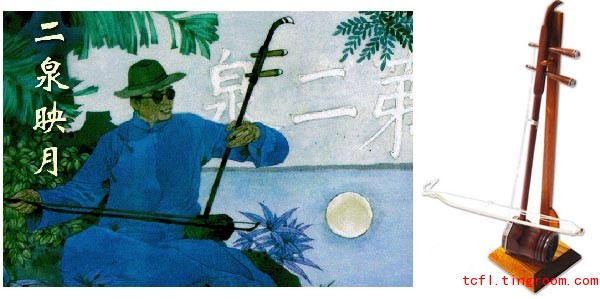It first originated in the northern frontier regions during the Tang Dynasty, and has more than a thousand years of history. At that time, the Erhu was known as a "Huqin", literally the "Hu violin". Tang Dynasty poet Cen Sen once wrote this:
zhōng jūn zhì jiǔ yǐn guī kè ,hú qín pí pá yǔ qiāng dí
中军置酒饮归客,胡琴琵琶与羌笛。
Wines are offered by the Commander to entertain his returning frontier troops;
In accompaniment to the banquet are huqin, pipa and qiang bamboo flutes.
What Cen Sen had written is proof that the huqin had become popular in the Tang Dynasty.
The Erhu is a long-handled wooden barrel instrument with two strings. One side of its music barrel is covered by snake skin leather. Its sound resonates between the mid and treble sound range, and has similar emotional and expressive qualities as the human voice.

[èr hú]二胡 Erhu
[yuè qì]乐器 musical instrument
[yīn yuè]音乐 music
The Erhu first appeared on stage as a solo instrument in the 1920s thanks to the great contributions made by famous erhu solo players Hua Yanjun(also nicknamed Blind A-Bing) and Liu Tianhua. Prior to this, the Erhu was more often used as part of a folk music concert or to the accompaniment of folk songs and operas. By far the most famous representative Erhu soloist pieces include "二泉映月(èr quán yìng yuè) The Reflection of the Moon" which is soul-inspirational, and "江河水(jiāng hé shuǐ)The River Water" that is moody and heart-touching.
 English
English Japanese
Japanese Korean
Korean French
French German
German Spanish
Spanish Italian
Italian Arab
Arab Portuguese
Portuguese Vietnamese
Vietnamese Russian
Russian Finnish
Finnish Thai
Thai dk
dk